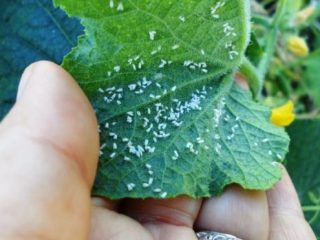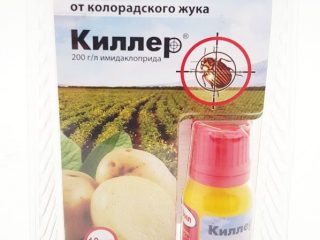Content
Whiteflies can appear on roses every summer. This is a small flying insect that resembles a white moth. It reproduces well, several generations develop per season. It feeds on the juice of young leaves, which causes them to dry out and the buds to become deformed. To combat insects, traps, folk remedies and chemicals are used.
Does whitefly attack roses?
The whitefly is a small flying insect that feeds on the juices of various plants, including roses. It is dangerous in its adult stage and in its larval form. The latter secrete a sugary, sticky liquid reminiscent of the honeydew produced by aphids.
The danger of whiteflies is due to the fact that the insect is very prolific and goes through several development cycles per season. It has wings and quickly flies from place to place. As a result, great damage is caused to the rose:
- Covers leaves with mucus. Interferes with cellular respiration and photosynthesis processes;
- Sticky leaves dry out.
- The buds become deformed and stop blooming.
- Larvae and adult whiteflies feed on young rose leaves, which weakens the plant.
Roses do not die even after a severe whitefly infestation. But the plants look clearly weakened, do not develop, and lose their decorative qualities. The pest can multiply and infect neighboring plantings. Therefore, you should start fighting insects as early as possible.
Description of the pest
The roseate whitefly resembles a tiny moth. This is a small sucking insect with a body 1-2 mm long. The color can be yellow, rarely with a dark pattern. Covered with pollen or a waxy coating resembling flour. The antennae of the whitefly are long and have from 3 to 7 segments. The insect has two pairs of wings, they are opaque and also covered with white powdery pollen. The eyes have a complex structure and are well developed. The legs are elongated and consist of two segments.

Whitefly on a rose leaf
During the season, the insect goes through the following stages of development:
- Adult females lay grayish eggs. The quantity is small - from 10 to 20 pieces, in favorable weather up to 300 eggs. In this case, the eggs are attached to the inside of the leaves of roses and other plants.
- Whitefly eggs on roses produce greenish, oval-shaped larvae. They have antennae and three pairs of legs, with which they move along the surface.
- The larvae stick to a rose leaf, lose their antennae and legs and feed without leaving one place. At this moment, the pest looks like small white scales.
- Whitefly larvae molt several times, after which they form a false cocoon and stop feeding.At this stage, an adult insect is formed - within 3-5 weeks.
- After this, the cycle of whitefly development on the rose is repeated.
Signs of defeat
The insects are quite small, but they can be seen on roses with the naked eye, since there are a lot of moths. An invasion can be determined by the following signs:
- sticky, viscous liquid on rose leaves;
- Over time, it dries out, causing plaque to form;
- Numerous translucent scales are visible on the underside of the leaf blades - these are whitefly larvae;
- the green part of the plant dries out;
- the buds are deformed, which is why flowering is not as abundant.
Reasons for appearance
Whiteflies are ubiquitous in temperate regions, so it is impossible to completely protect against their appearance. They live even in the city and often fly into apartments, parasitizing indoor roses and other plants.
There are several factors that provoke pest invasion:
- hot summer, consistently high daytime temperatures;
- high humidity;
- too thick plantings;
- lack of air circulation.
Whiteflies thrive in moist environments if the air temperature is high enough. It is impossible to influence most of the factors described. When growing roses, you need to ensure normal watering without giving too much water. If plants are grown in greenhouses, it is important to ventilate them regularly.
How to deal with whitefly on roses
There are several proven methods to combat whitefly on roses. The pest can be quite easily destroyed with the help of insecticides - special chemicals. If the invasion is not too large, it is recommended to treat it with folk remedies - decoctions, solutions or water infusions.You can also use traps to control whiteflies.
Preparations for whiteflies on roses
If whitefly appears on climbing or other roses, you need to treat the bushes with chemicals. The most powerful insecticides include:
- "Biotlin" is an effective drug against whiteflies. Also helps control aphids, thrips and leafhoppers. The protective effect lasts up to three weeks.
- "Biotlin BAU" is an enhanced version of the previous drug. Provides protection against pests for three weeks.
- "Tanrek" is a systemic insecticide. Provides protection throughout the season. Treatments can be carried out even in rainy weather;
- “Tsvetolux” is a systemic drug with a convenient spray cap that provides protection for up to 30 days.

"Biotlin" is one of the effective drugs against whiteflies
Folk remedies for whiteflies on roses
Folk remedies are also used to combat whiteflies on roses and other plants:
- You can start by simply washing the leaves with water using a soft sponge. This will allow you to collect and destroy almost all the larvae. You can add 3-4 tablespoons of laundry soap shavings (per 10 liters) to the water.
- Prepare garlic infusion - 300 g of crushed cloves per 10 liters. Let it sit for several hours, maybe a day, then strain and begin processing.
- Infuse 1 kg of fresh crushed yarrow leaves, wait a day, strain and thoroughly spray the bush.
- Infuse tobacco dust - a 10 liter glass. Wait 3-4 days, strain and spray the plants.
Since folk remedies are not so dangerous, it is better to carry out treatments several times a season until the pest is completely destroyed. The standard interval is 3-5 days. A combined scheme can also be used. For example, first treat with a homemade solution and after a week re-treat with an insecticide. This combination allows you to completely destroy whiteflies.
Mechanical methods
It is unrealistic to manually collect insects on roses, but they can be neutralized using traps. To combat the pest, use universal sticky tapes (for flies) and special traps for white-winged flies. They work most effectively in greenhouses.
Traps can be purchased at the store or made yourself:
- Take cardboard that is bright yellow or blue, as this is what attracts these insects.
- Cut into rectangles the size of a notebook sheet;
- A hole is pierced in the upper part and a loop is threaded.
- The entire surface is coated with honey, Vaseline, rosin or special entomological glue.
- Suspended at a low height. In the evening, you can turn on bright lamps next to them - then the pests will definitely fall into the trap. They will die by burning their wings on the light source.
Resistant varieties
To date, no special varieties of roses resistant to whiteflies have been developed. To one degree or another, all varieties are affected by this insect, so it is necessary to take preventive measures, inspect the plantings in a timely manner and, if necessary, carry out treatments.
You can also pay attention to varieties of roses that are resistant to various diseases and adverse weather conditions: Peace, Angela, Leonardo da Vinci, Rosarium Uetersen, Augusta Luise, Westerland, Golden Celebration, Abraham Darby and others.

Angela is one of the varieties resistant to various diseases
Prevention
It will not be possible to completely eliminate the whitefly invasion on a rose. However, it is possible to prevent the proliferation of pests by reducing their numbers and preventing their spread throughout the area. To do this, experienced gardeners recommend using the following methods of prevention:
- Don't plant roses too close. Even if the area is small, at least 50 cm should be left between shrub varieties, and at least 1 m between rows. Dense planting of roses provokes the rapid spread of not only whiteflies, but also other insects, as well as fungal infections.
- Do not violate the watering norm - it is better to give a little less water than to constantly flood the area.
- To keep the soil moist enough for as long as possible, it is recommended to mulch the plantings with sawdust, hay, straw or other materials.
- In the fall, the soil in the tree trunk circle is dug up.
- After pruning the rose, remove all leaves, shoots and other plant debris. They need to be taken and burned.
Conclusion
Whiteflies on roses are numerous, reproduce well and can provoke the development of other diseases, such as sooty fungus. However, it is quite possible to cope with the invasion. To do this, it is recommended to use folk remedies. If they are not effective enough, they should be treated 1-2 times with special chemical insecticides.









